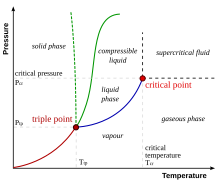Structural Biochemistry/Phase Diagrams
Introduction of phase diagrams
[edit | edit source]
A phase diagram is a chart that helps define the conditions at which a substance can be in its solid, liquid, and vapor states. The three boundary lines of the chart signify the equilibrium relationships between the phases: fusion curve, vaporization curve, and sublimation curve. There are also two distinct points on the graph: the triple point and the critical point. To better define these terms the picture diagram can be examined. The red line is the transition between solid to gas and is also called the sublimation curve. The green line is from solid to liquid and is also called the fusion curve. The blue is liquid to gas and is called the vaporization curve. The point where all three lines intersect is the triple point. At this temperature and pressure the three phases: solid, liquid, and vapor can coexist. The critical point is the condition of the highest pressure and temperature that the substance can be observed in vapor/liquid equilibrium.
Supercritical
[edit | edit source]Any condition that exceeds that highest pressure and temperature becomes a region that has no definite phase boundaries. A phase is usually considered a liquid when vaporization comes from pressure reduction at constant T, the same goes for a gas if condensation results from temperature reduction at constant T. Since this process cannot be applied to either situation the region beyond the highest P and T can be regarded as supercritical and as the fluid region.
A supercritical fluid is defined as a substance above its critical temperature (Tc) and critical pressure (Pc). The critical point represents the highest temperature and pressure at which the substance can exist as a vapour and liquid in equilibrium. Supercritical fluids are highly compressed gases which combine properties of gases and liquids in an intriguing manner. Fluids such as supercritical xenon, ethane and carbon dioxide offer a range of unusual chemical possibilities in both synthetic and analytical chemistry. Supercritical fluids have solvent power similar to a light hydrocarbon for most solutes. However, fluorinated compounds are often more soluble in scCO2 than in hydrocarbons. This increased solubility is important for polymerisation.
Phase Diagram for proteins
[edit | edit source]
Though phase diagrams are generally viewed as a map that shows the state of a substance at certain conditions, this simple tool can be used to analyze other complicated materials. An example is that the information derived from a phase diagram can be used for the discussion of protein crystallography. This diagram is a representation of what protein and precipitant concentrations are needed for protein crystallography. The red line is called the solubility line and it distinctly separates undersaturated conditions from the supersaturated, which is the condition desired for protein crystallization. The supersaturated part of the diagram consists of three parts: metastable, labile, and precipitation.
Supersaturated
[edit | edit source]Metastable-Crystals here can grow larger from seeds but they cannot nucleate. There is a lower protein and precipitant concentration with less aggregation events. This zone signifies the concentrations that are usually too slow for crystallization to occur.
Labile-Crystals here can also grow larger from seeds but they can nucleate. There is a higher protein and precipitant concentration with more aggregation events. This zone is also known as the nucleation zone or the crystallization zone and is more favorable for the formation of crystals.
Precipitation-Proteins usually surface as an aggregate or precipitate and are not used for crystallography. This section of the diagram displays less favorable conditions because aggregation and precipitation occur much faster than crystallization.
Nucleation: process of creating a nucleus.
Aggregation: the clumping or clustering of proteins.
Use of phase diagrams for protein crystallization
[edit | edit source]The connection between phase diagrams and protein crystallization is the placement of the solubility curve (the red line). As described, crystals can only form in supersaturated solutions and having information on the location of the solubility curve allows for the growth of crystals for X-ray crystallography. Though crystals are needed to determine the solubility curve, it is through various trials that the suitable concentrations for crystal formation are found. By this accumulation of data the crystals can be used as a guide for refining conditions for protein crystallization.
This phase diagram is used also because it unveils the interactions between the many components of the solutions. Examples of such interactions are the liquid-liquid phase separation (LLPS) that define the attraction between proteins, a necessary characteristic for crystallization of proteins. This attraction is thoroughly defined in LLPS. Other data that can be extracted from the phase diagram include enthalpies (from LLPS) and entropies (from solubility curve) of the protein in liquid and solid states. Also, additives can change the curves of the phase diagram giving data on the effect of the additive and how it interacts with the protein analyte. It can also be utilized for predictions of the conditions that are needed for a variety of protein crystallization which would be ideal for the crystallization process, less trial and error, more crystallizing.
Liquid-liquid phase separation (LLPS)
[edit | edit source]A result of adding precipitant to a protein solution is the formation of liquid drops. These liquid drops are sometimes referred to as oils or coacervates and can be observed at changing temperatures, pHs, and other solution condition changes. The drops usually contain high protein concentrations and when influenced by a higher force, gravity, the drops separate from the rest of the solution. The result of this is two liquid phases from the solution. This entire process is called liquid-liquid phase separation. LLPS is useful because the high concentrations of proteins help increase saturation to a supersaturated state which, as a result, increases crystallization.
